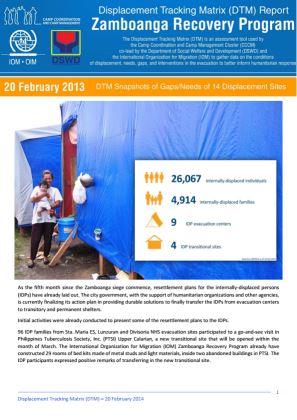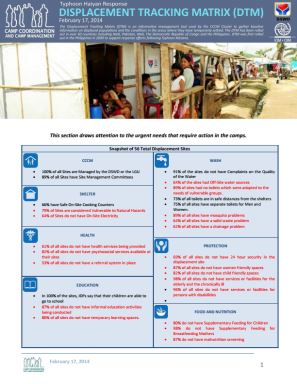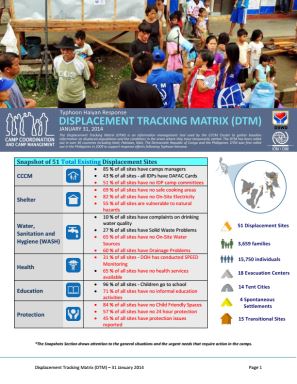-
Countries
-
Data and Analysis
-
Special Focus
-
Crisis Responses
Philippines
Philippines
Suivi des PDI
Mouvements de déplacement
113,000
IDMC 2023
cycle de collecte de données
À propos Philippines
The Displacement Tracking Matrix (DTM) was first rolled out in the Philippines in 2009 following Typhoon Ketsana (Ondoy) and has since been used to support response efforts to major emergencies in the country including Typhoons Washi (Sendong), Bopha (Pablo), Haiyan (Yolanda), Bohol Earthquake and the Zamboanga and Marawi Crises. IOM Philippines has been promoting the adoption of the system by government partners both at national and local levels.
The Philippines’ Department of Social Welfare and Development (DSWD) has agreed to use the DTM site assessment tool to monitor the needs of the displaced populations in evacuation centres and other displacement settings. In addition, the DSWD has piloted the DTM Biometric Registration and Verification (BRaVe) system as a preparedness measure to register vulnerable families in hazard-prone communities and is considering using the system for its other programmes.
Contacter
Francis BORJA
Information Management Officer
FBorja@iom.int
Bailleurs de fonds
- ECHO
Philippines — Typhoon Haiyan Displacement Report (31 March 2014)
Typhoon Haiyan hit the Philippines on 8 November 2013. It was one of the most powerful typhoons to ever make landfall.
Philippines — Zamboanga Recovery Programme Report (14 March 2014)
This DTM Report reflects the sectoral snapshot based on the DTM as of 14 March 2014. There are 4,873 displaced families with 25,840 individuals in nine evacuation centers and five transitory sites.
Philippines — Zamboanga Recovery Programme Report (20 February 2014)
As the fifth month since the Zamboanga siege commence, resettlement plans for the internally-displaced persons (IDPs) have already laid out.
Philippines — Typhoon Haiyan Displacement Report (17 February 2014)
There are a total of 56 displacement sites covered by this report which is an increase of 9 % from the previous report. This is due to a 100 percent increase in transitional sites which increased from 15 to 30 sites; thus comprising 53% of all displacement sites.
Philippines — Typhoon Haiyan Displacement Report (31 January 2014)
Typhoon Haiyan hit the Philippines on 8 November 2013. It was one of the most powerful typhoons to ever make landfall.
Philippines – Mindanao Earthquake – Site Profile R2 – Santos Land (November 2019)
Three major earthquakes hit North Cotabato on 16, 29 and 31 October 2019, at 6.3, 6.6 and 6.5 magnitudes, respectively.
Pagination
- First page
- Previous page
- 1
- 2
- 3
- 4
- 5








